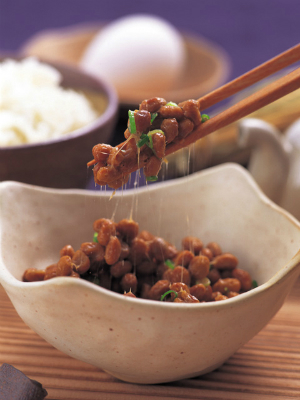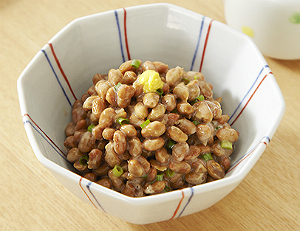Natto | Articles on Japanese Restaurants | Japan Restaurant Guide by Gourmet Navigator
Natto Summary

It is a fermented product unique to Japan made of soybeans fermented with the Bacillus subtilis var. natto. It is sold in supermarkets all over Japan, and there are large bean types, small bean types, ones that are cut into pieces called 'hikiwari natto", and ones that use black beans. In recent years the variations have tend to increase. Mito city, Ibarki prefecture is famous as a producer of natto across Japan.
Wasyoku(Japanese Cuisine) encyclopedia : Natto

It is well known that "Natto of mito" is synonymous with delicious natto. Originally most people of the Kansai region tended not to like natto, but in recent years the difference in consumption have lessened. Since the Bacillus subtilis var. natto produces a distinct smell and stickiness, it is considered an acquired taste, but in recent years, health-promoting effects of nattokinase contained in the bacteria has been featured in the media, and the natto is becoming seen as a health promoting product. The producers of natto have devised improvements such as improving the bacteria so it produces less smell and stickiness, and packages have been developed that prevent the hand from becoming dirty.
It is said that soy beans were introduced to Japan during the Jomon period, but it is not certain when natto had begun to be produced. It was valued during the Warring States period as a vital protein source for the military commanders, and in Edo during the Edo period, "natto sellers" had walked around and sold natto. The most orthodox way of eating natto is natto placed on top of rice called "natto gohan". There are some who prefer to mix the natto well to make it more sticky, and those that find mixing a few times with the soy sauce or sauce to be enough, and it depends on the person's preference. Besides soy sauce, sauce, and Japanese mustard, chicken eggs or quail eggs can be added to achieve a mild flavor.

Scallions, myoga, and grated daikon raddish can be added as condiments, and adding bonito flakes, nori, or aonori can be delicious. It can also be placed on cold tofu called "hiyayakko", or eaten with other sticky foods like chinese yam, mekabu,or okra, and is popular as a healthy dish. In Hokkaido and the Tohoku region, adding sugar is common, and in Fukushima prefecture it is sometimes eaten with pickled Chinese cabbage. It can be used as an ingredient for miso soup, and "natto soup" which uses chopped natto was eaten more frequently than with rice during the Edo period. it can be added to soba, udon, spaghetti, Japanese curry, okonomiyaki, and tempura. A "natto makzuki" made by making makizushi with natto is very popular, and it can be seen as a regular product in convenience stores.








